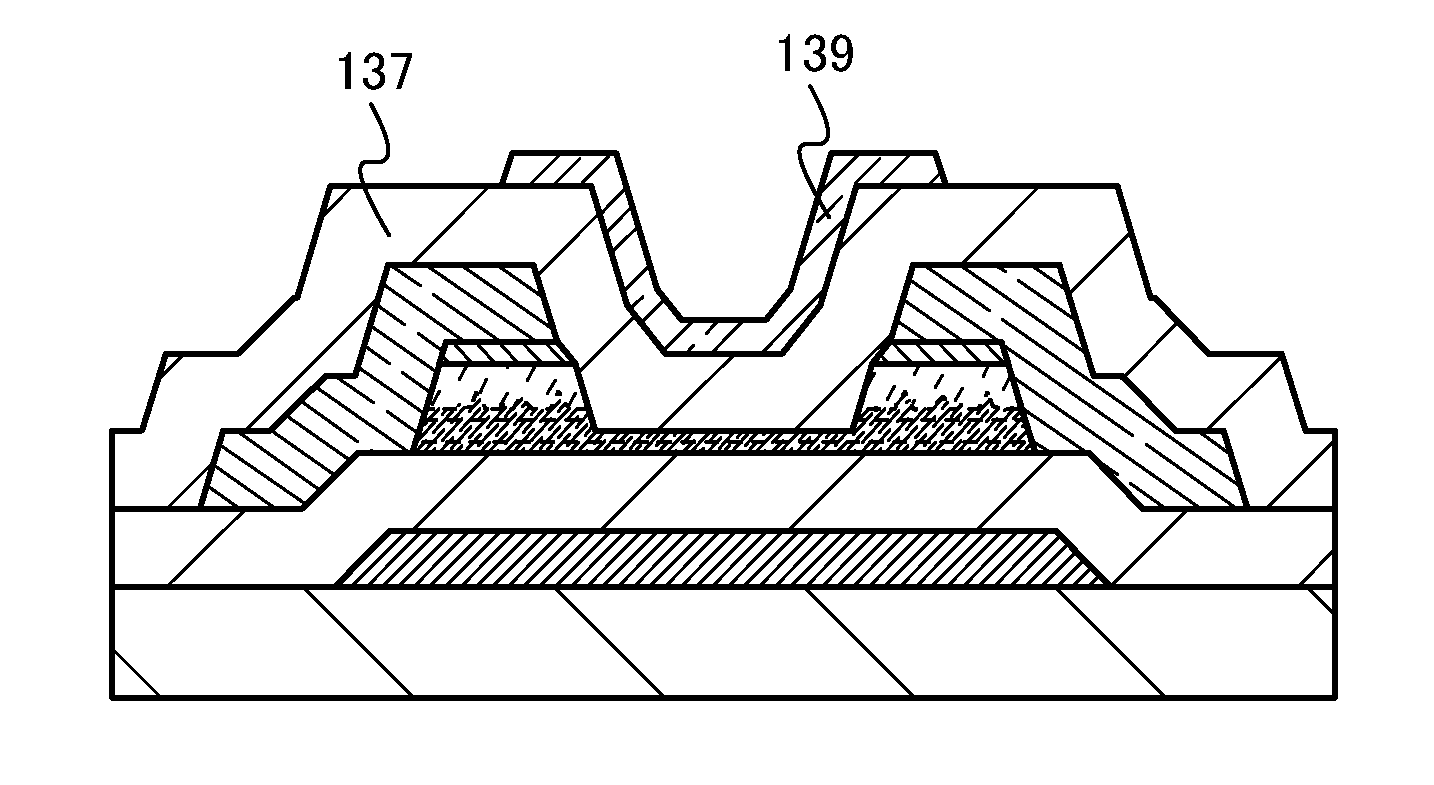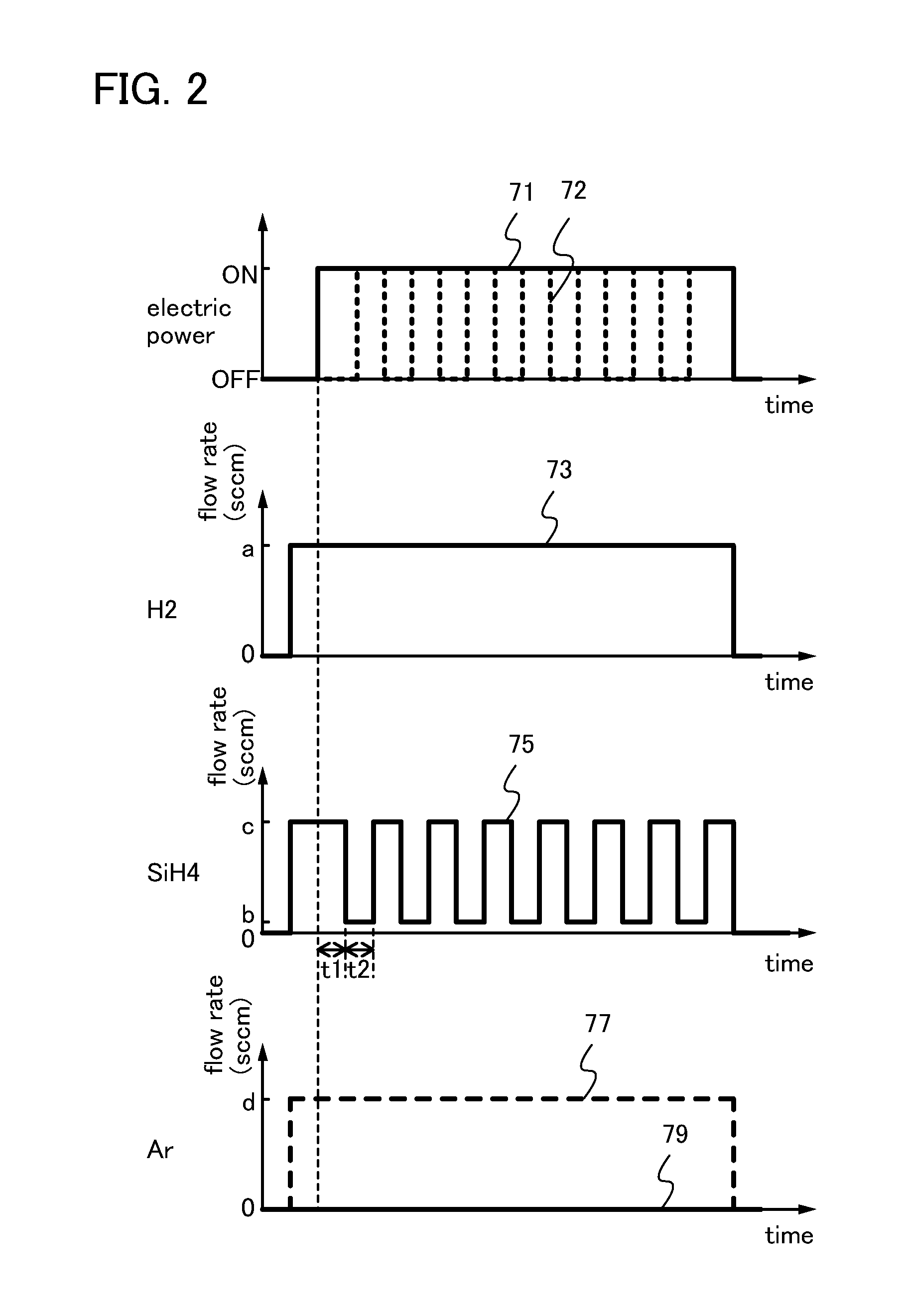Method for manufacturing semiconductor device
a manufacturing method and technology for semiconductor devices, applied in semiconductor devices, chemical vapor deposition coatings, coatings, etc., can solve the problems of low field-effect mobility and low on-state current, high manufacturing cost, and inability to obtain sufficient switching characteristics, etc., to achieve high production efficiency, high crystallinity, and favorable electrical characteristics
- Summary
- Abstract
- Description
- Claims
- Application Information
AI Technical Summary
Benefits of technology
Problems solved by technology
Method used
Image
Examples
embodiment 1
[0048]In this embodiment, a method for forming a microcrystalline semiconductor film having high density and high crystallinity will be described with reference to FIGS. 1A and 1B and FIG. 2.
[0049]As illustrated in FIG. 1A, an insulating film 55 is formed over a substrate 51, and a seed 57 is formed over the insulating film 55.
[0050]As the substrate 51, a glass substrate, a ceramic substrate, a plastic substrate which has high heat resistance enough to withstand a process temperature of this manufacturing process, or the like can be used. In the case where the substrate does not need a light-transmitting property, a metal substrate, such as a stainless steel substrate, provided with an insulating film on its surface may be used. As the glass substrate, for example, an alkali-free glass substrate of barium borosilicate glass, aluminoborosilicate glass, aluminosilicate glass, or the like may be used. Note that there is no limitation on the size of the substrate 51. For example, any of...
embodiment 2
[0085]In this embodiment, a method for forming a microcrystalline semiconductor film having higher crystallinity than the microcrystalline semiconductor film in Embodiment 1 will be described with reference to FIGS. 1A and 1B and FIG. 3.
[0086]As in Embodiment 1, the seed 57 and the microcrystalline semiconductor film 59 are formed through the process of FIGS. 1A and 1B.
[0087]Next, as illustrated in FIG. 3, a second microcrystalline silicon film 61 is formed over the microcrystalline silicon film 59.
[0088]The second microcrystalline silicon film 61 is formed in a treatment chamber of the plasma CVD apparatus, using glow discharge plasma with the use of a mixture of hydrogen and a deposition gas containing silicon or germanium under a third condition. Alternatively, the second microcrystalline silicon film 61 may be formed using glow discharge plasma with the use of a mixture of hydrogen, a deposition gas containing silicon or germanium, and a rare gas such as helium, argon, neon, kry...
embodiment 3
[0091]In this embodiment, a method for manufacturing a thin film transistor formed in a semiconductor device that is one embodiment of the present invention will be described with reference to FIGS. 4A to 4D, FIGS. 5A and 5B, FIGS. 6A to 6C, and FIGS. 7A to 7D. Note that an n-channel thin film transistor has higher carrier mobility than a p-channel thin film transistor. Further, it is preferable that all thin film transistors formed over the same substrate have the same polarity because the number of manufacturing steps can be reduced. Therefore, in this embodiment, a method for manufacturing an n-channel thin film transistor will be described.
[0092]Note that the term “on-state current” refers to current which flows between a source electrode and a drain electrode when a thin film transistor is on. For example, in the case of an n-channel thin film transistor, the on-state current refers to current which flows between a source electrode and a drain electrode when gate voltage is hig...
PUM
| Property | Measurement | Unit |
|---|---|---|
| pressure | aaaaa | aaaaa |
| pressure | aaaaa | aaaaa |
| pressure | aaaaa | aaaaa |
Abstract
Description
Claims
Application Information
 Login to View More
Login to View More - R&D
- Intellectual Property
- Life Sciences
- Materials
- Tech Scout
- Unparalleled Data Quality
- Higher Quality Content
- 60% Fewer Hallucinations
Browse by: Latest US Patents, China's latest patents, Technical Efficacy Thesaurus, Application Domain, Technology Topic, Popular Technical Reports.
© 2025 PatSnap. All rights reserved.Legal|Privacy policy|Modern Slavery Act Transparency Statement|Sitemap|About US| Contact US: help@patsnap.com



